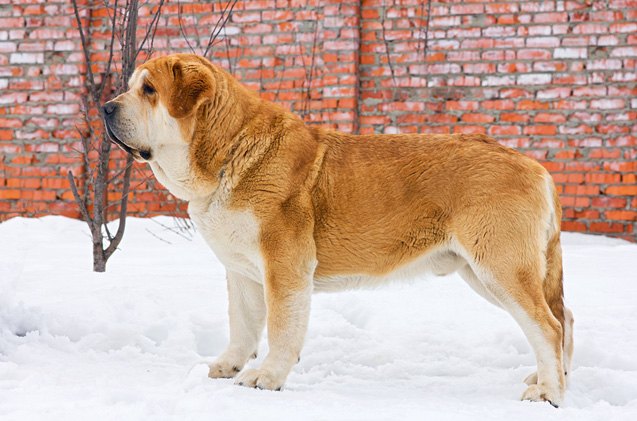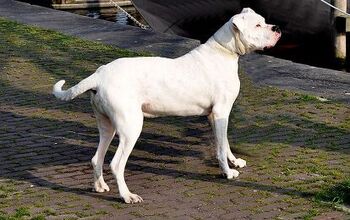Spanish Mastiff


About Spanish Mastiff
The fact that this breed has “mastiff” in its name should provide you with some basic information about this dog. Like all mastiffs, the Spanish Mastiff is a large dog with a heavy, muscular build that excels as a guard dog. If you are looking for a large-breed dog with natural guarding skills that is still a good family companion, consider the Spanish Mastiff.
The Spanish Mastiff is a large canine with a heavy, muscular build, and excels as a guard dog.
The Spanish Mastiff is recognized as an ancient breed, though its exact origins are unknown. Mentions of a Spanish Mastiff-like breed can be traced back more than 2,000 years to the Iberian Peninsula where the ancestors of the breed were likely introduced by the Phoenicians and Greeks prior to the Roman invasion. The Spanish Mastiff was largely used as a herding dog and a livestock guardian in Europe and there is some evidence to suggest that the breed may have also been used in battles the Spaniards had against native peoples.
The ancestry of the Spanish Mastiff is unknown but the breed is likely descendant from dogs that were brought to the Iberian Peninsula by Phoenician traders. The Spanish Mastiff likely originated from an ancient Molosser-type dog and it played a role in the development of other Mastiff breeds like the Dogo Argentino and the Saint Bernard.
As a large-breed dog, the Spanish Mastiff should be offered a commercial diet specially formulated for dogs of its size. If your dog is particularly active you may want to consider an active breed formula to ensure that his energy needs are being met. It is very important that you feed Spanish Mastiff puppies a large-breed puppy formula to prevent them from growing too quickly.
Spanish Mastiffs are noble and dignified, even though they can appear lazy at times.
The Spanish Mastiff has natural protective instincts which is why it was used for so many years as a guard dog and livestock guardian. These dogs are gentle by nature and they form very close bonds with family but they sometimes develop a willful, independent nature. It is also worth noting that it could take 3 years or more for the Spanish Mastiff to outgrow the puppy phase, so training can be challenging. Your best bet is to use positive reinforcement training methods and to maintain a firm and consistent hand in leadership over the dog. This breed will sometimes ignore commands so they are not recommended for inexperienced dog owners. Early socialization and training is essential for this breed.
The Spanish Mastiff is classified as a giant breed and there are some specimens of the breed that have grown to over 200 pounds. The average size for males of the breed is 110 to 150 pounds and, for females, between 88 and 132 pounds.
Though the Spanish Mastiff can sometimes be willful and independent by nature, it develops very strong bonds of loyalty with family. These dogs have natural protective instincts and they will not hesitate to protect the ones they love. Spanish Mastiffs are noble and dignified, even though they can appear lazy at times. These dogs do have a good bit of speed when it becomes necessary and they are always on the watch, even if it seems like they aren’t. This breed requires a lot of socialization because they can be stubborn by nature and because their size makes them a potential risk around other dogs and people. For the most part, these dogs do get along with children but you should always supervise interactions.
As a large-breed dog, the Spanish Mastiff is prone to a number of musculoskeletal issues including hip dysplasia and elbow dysplasia. It is very important that this breed not be allowed to grow too quickly as a puppy because it is likely to suffer from pano-ostiosis, or growing pains, and the fast growth can predispose the dog to musculoskeletal issues later in life. Other health problems known to affect the breed include heart problems, entropion, and breathing problems.
As a giant breed, the Spanish Mastiff has a fairly short lifespan averaging 10 to 11 years.
The Spanish Mastiff is not an overly active breed but these dogs do need a daily walk in order to meet their exercise needs. This breed is most active as a young adult so it may need additional exercise for the first few years.
These dogs have natural protective instincts and they will not hesitate to protect the ones they love.
The Spanish Mastiff was admitted into the AKC’s Foundation Stock Service in 2008. It has since been assigned the working group designation but registration numbers are not yet sufficient for the breed to be fully accepted for competition.
The Spanish Mastiff has a short coat that comes in a variety of colors including yellow, black, red, brown, and gray as well as broken colors and spotted patterns. The tail is fringed with fur and the hair on the center of the back might be a bit longer than the rest of the body. Because the Spanish Mastiff’s coat is so short and dense it does not need a lot of maintenance or grooming. Regular brushing will help to keep shedding under control and bathing is only recommended when necessary.
Many Mastiff breeds have very large litter sizes of up to 10 puppies and this may also be true for the Spanish Mastiff. Because the Spanish Mastiff grows to an average size over 100 pounds it may take longer than a year for puppies to become full grown – in many cases it can take 3 years or so for the Spanish Mastiff to completely outgrow the puppy phase. It is very important that you feed Spanish Mastiff puppies a large-breed puppy formula to prevent them from growing too quickly and putting excess strain on their bones and joints.
Photo credit: sergeymakarenko/Bigstock; Laures/Bigstock

Kate Barrington is the loving owner of two cats (Bagel and Munchkin) and a noisy herd of guinea pigs. Having grown up with golden retrievers, Kate has a great deal of experience with dogs but labels herself a lover of all pets. Having received a Bachelor's degree in English, Kate has combined her love for pets and her passion for writing to create her own freelance writing business, specializing in the pet niche.
More by Kate Barrington

























